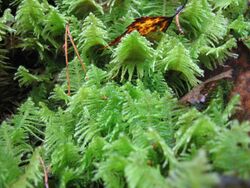Biology:Feather moss
Feather moss (or Boreal forest moss) is a moss species growing in a Boreal forest with the appearance of frond or feather like foliage.[1]
The technical literature is inconsistent regarding taxonomic associations with the term feather moss. In some cases, feather moss is simply applied to the genus Ptilium, or to a number of moss species within the family Hypnaceae.[1]
Ecology
Feathermoss is a term used in classifying and describing certain boreal forests. An example of this occurrence is within the Black Spruce/Feathermoss climax forest, often having moderately dense canopy and featuring a forest floor of feathermosses including Hylocomium splendens, Pleurozium schreberi and Ptilium crista-castrensis.[2] These weft-form mosses[3] are shaped to allow the needles to fall into them rather than covering them, so they grow over the needles.[4]
Feather flat moss (Neckera pennata) can be an indicator of late successional and old-growth hardwood forests, because it usually grows on sugar maples in the Northeast[where?] that are at least 120 years old.
Feather mosses have important roles in boreal forests as they can regulate the temperature and moisture of soils.
See also
- Black spruce
- Fern moss
References
- C. Michael Hogan. 2008. Black Spruce: Picea mariana, GlobalTwitcher.com, ed. Nicklas Stromberg
- Pat Diehl Scace. 2001. The Floral Artist's Guide: A Reference to Cut Flowers and Foliages, published by Cengage Learning, ISBN:978-0-7668-1572-8, 264 pages
Line notes
- ↑ 1.0 1.1 Pat Diehl Scace. 2001
- ↑ C. Michael Hogan, 2008. Black Spruce: Picea mariana, GlobalTwitcher.com, ed. Nicklas Stromberg
- ↑ Poller, Sonya (22 January 2015). "Alberta’s Wonderful World of Bryophytes". Alberta Biodiversity Monitoring Institute. http://blog.abmi.ca/2015/01/22/albertas-wonderful-world-of-bryophytes/.
- ↑ Cullina, William. "Gardening With Moss" (in en). https://www.hortmag.com/plants/gardening-with-moss.


